The Philadelphia Flyers have no doubt just gone through one of the most up-and-down seasons in their 50-year history. There was a point this season when I was writing about the Flyers being one of the top teams in the Eastern Conference, a force to possibly make a deep run in the playoffs. That all quickly went by the wayside.
There I sat, in that same spot just three months later, writing about how the Flyers winning games in late March was just prolonging the inevitable. If that isn’t a tale of two seasons, I don’t know what is.
A month after writing that article, I now sit in that same spot once again, trying to piece together what possibly could have happened to a team that appeared to have so much promise in late December. I’ll break down each segment of the Flyers and grade them. Here is your 2016-17 Philadelphia Flyers Report Card.
The Offense
The offense could essentially be split into two divisions: the first and second line and then another division with the third and fourth line. However, this is a team game, so we won’t do that.
As I mentioned above, the Flyers suffered a tale of two seasons this year. In the first half, they were one of the better teams in the league and in the second half, they were one of the worst teams in the NHL. That same sentiment rang true for the offense.
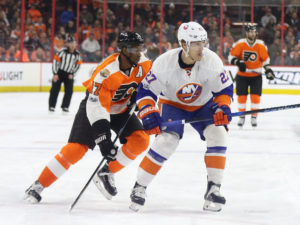
To make things easy, the “better half” of the season will be through the end of the winning streak, and the “worse half” of the season will be everything after that.
During the better half of the season, the Flyers were averaging far above three goals a game, had one of the league’s best power plays, and were getting consistent scoring from their top two lines. When you dig into individual player stats, things get even more impressive.
In the better half of the season:
- Jakub Voracek was fifth in the NHL in scoring (33 PTS, 32 GP)
- Claude Giroux was ninth in the NHL in scoring (30 PTS, 32 GP)
- Wayne Simmonds was 10th in the NHL in scoring (29 PTS, 32 GP)
- Wayne Simmonds was 4th in the NHL in goals (16 G)
Now, let’s rattle off the same numbers for those guys in the worse half of the season:
- Jakub Voracek was 137th in the NHL in scoring (28 PTS, 50 GP)
- Claude Giroux was 142nd in the NHL in scoring (28 PTS, 50 GP)
- Wayne Simmonds was 162 in the NHL in scoring (25 PTS, 50 GP)
- Wayne Simmonds was 75th in the NHL in goals (15 G)
To be quite honest, there’s no easy way to explain a decline such as that. Simply put, the lack of scoring the Flyers experienced in the second half of the season was the reason they missed the playoffs.
The lack of production wasn’t just at the top; it was even worse on the back end. It’s hard to put a number on this considering the Flyers jumbled lines a lot, but the two checking line staples (Pierre-Edouard Bellemare, Chris VandeVelde) had a combined 9 points in their last 50 games.

Sure, they’re fourth-line players, but those numbers are atrocious. It was almost like whenever they were out on the ice, it’d be considered a successful shift if the other team didn’t score. It’d be considered a wild surprise if they generated some offense or even scored a goal. That isn’t what a fourth line should feel like.
If you had watched any of the Flyers’ games in the second half of the season, you would have surely recognized the lack of scoring. The games were flat-out boring. They were akin to watching the 1990s New Jersey Devils sit back and play a trap game, and the only difference was the Flyers couldn’t win games at all.
The Flyers’ offense showed some serious promise at the beginning of this season, but in the end, it was their ultimate demise and the reason why they aren’t playing into April and May.
Offensive Grade: C-
The Defense
This might sound crazy, but the Flyers’ defense really wasn’t all that bad this season.
To make things clear, there wasn’t a lot expected of the Flyers defense this season. Andrew MacDonald is a salary-cap disaster, Ivan Provorov was a rookie, and Shayne Gostisbehere was quick on his feet but was primarily an offensive defenseman. All of this was known coming into the season, but a high-powered offense should provide some relief to this.
And it did.
Early on, the Flyers were one of the highest-scoring teams in the league, but they also gave up a ton of goals. Goaltending wasn’t all that great at times, but the defense was primarily responsible for this.
What’s even more puzzling is that as the Flyers began to lose games, their defense was actually improving.
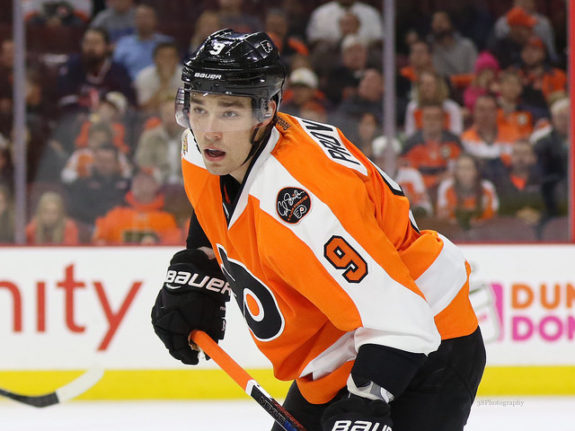
In the better half of the season, the Flyers gave up an average of 2.97 goals per game. That was third-worst in the NHL. In the worse half of the season, the team only surrendered 2.71 goals per game. That’s a notable decrease in the number of goals they were allowing. They also allowed the third-fewest shots per game in the worse half, at just 28.14.
What’s even more important is that the Flyers showed major improvements on the defensive front as well. Radko Gudas finished the season as a plus-8 and cut his penalty minutes by almost 30, which was a big improvement from the prior season.
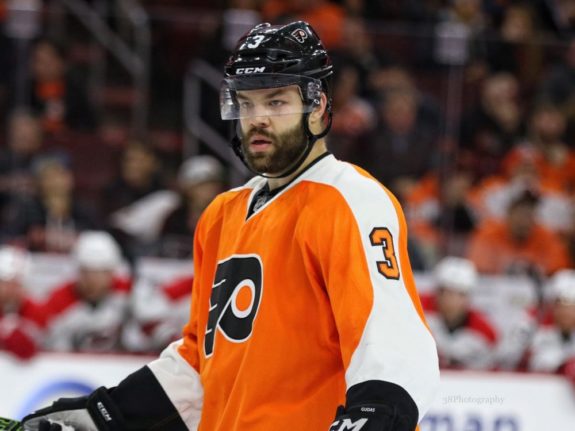
Gostisbehere powered through many senseless nights as a healthy scratch, and actually posted better possession metrics this year. He seemed to be back to his normal self towards the end of the season, proving to be a dynamic offensive defenseman; however, he seemed to take some shots at his coach at the end of the season.
Then there’s Provorov. After a night to forget early on in Chicago, the young defenseman rebounded and was arguably the Flyers’ crucial asset throughout the season. Provorov looked like a defenseman who had years of experience, and he was continually eating up 20-plus minutes a night.
The Flyers’ defense started out the season on a rough note but marginally improved toward the end. There’s a very bright future ahead here.
Defensive Grade: B
The Goalies
This is another case where the grade could literally be split down the middle.
In the part of the season before the start of the winning streak, the Flyers’ goaltending was without a single doubt the worst in the NHL. Both Michal Neuvirth and Steve Mason had save percentages that were south of the .900 mark. That was a huge shock considering both goalies had played exceptionally well the season before.
Then, as the offense began to crumble, Mason came to the forefront.
From the beginning of February until the end of the season, Mason was fourth in the NHL in save percentage (.926) and fifth in the NHL in goals-against average (2.14). He was far and away the only reason the Flyers even could sniff the playoffs throughout most of March.
Then, on the other hand, there was Neuvirth.
Neuvy had a stellar season in 2015-16 and looked to continue that into this past season. That didn’t happen.
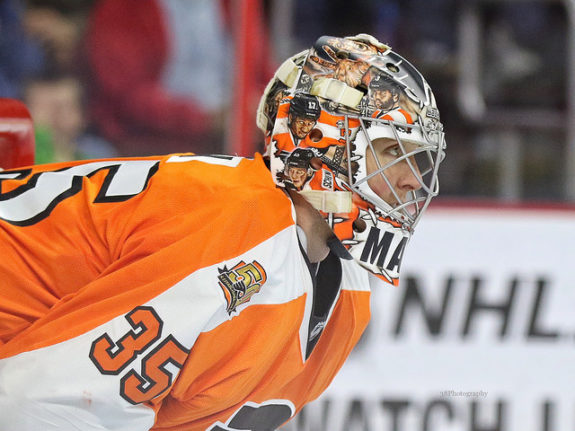
Fresh off his unbelievable performance against Washington in the playoffs, Neuvirth looked like an entirely different goalie at times this season. He, unlike Mason, faltered down the stretch and finished the year with a brutal .891 save percentage.
There was one bright spot for the future, and that was Anthony Stolarz.
Stolarz came into the backup role when Neuvirth went down with an injury in late November. He played very well in his first career start against the Calgary Flames and posted a shutout in his second start against the Detroit Red Wings.
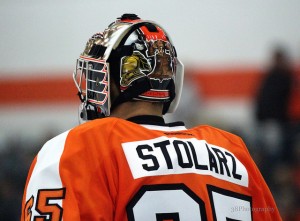
In the seven games he appeared in this season, he had a .928 save percentage and 2.07 goals-against average.
Despite the small sample size, those were by far the best numbers out of all three goalies this season.
The Flyers also made it clear that they are looking for a fresh start in net. Neuvirth was re-signed to bridge the gap between Mason and Stolarz. Despite Mason’s consistency, it really didn’t make sense for the Flyers to bring him back on a long-term deal that he likely would have wanted—especially when you consider the depth they have at the goaltending position.
Goalie Grade: B+
Coaching
It’s hard to know where to begin with this one.
You’d think that with one year under his belt, Dave Hakstol would have been able to rally his group to an even better season this year. That didn’t happen; in fact, this one was exponentially worse than the previous.
For one, the scratchings of Gostisbehere and Travis Konecny made absolutely zero sense throughout the course of this season. Gostisbehere was a healthy scratch on multiple occasions, seemingly due to the fact that he was a defensive liability. Yes, any offensive defenseman in this league is going to pose somewhat of a risk. It happens to the best of them, but that shouldn’t have been a reason to scratch the Ghost.
In fact, it visibly put a dent in his confidence.
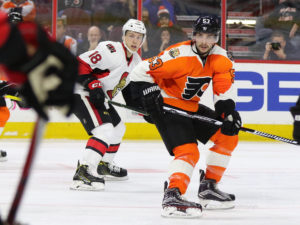
After being scratched, Gostisbehere wasn’t nearly as effective at creating plays or putting himself on the scoresheet. He wasn’t making those flashy moves on the breakout or at the blue line, and it cost the Flyers offensive opportunities and forced Gostisbehere to play a game that he wasn’t familiar with.
I mentioned what he said about “playing his game” toward the end of the season, and it was noticeable on the ice. Gostisbehere was back to making those nifty moves and looking to shoot rather than force passes.
The same thing went for Konecny. Taking a few bad penalties shouldn’t warrant a rookie being scratched night in and night out.
If Hakstol wanted to send a message to his young players, he could have benched them for a few shifts, not destroyed their confidence and try and make them change their game.
What’s even more frustrating is that removing these guys from the lineup was actually a detriment to the team itself. The Flyers aren’t loaded with back-end talent, meaning that when a guy like Konecny was scratched, his replacement didn’t bring anything close to what he did to the lineup.
The same went for Gostisbehere. When he was out of the lineup, it was likely that Nick Schultz was his replacement. Weigh those options, seriously, and when you look at it that way, who is really the bigger defensive liability?
Then, of course, there was the goaltending, and it was mismanaged in the worst way possible.
Mason was played for an extended stretch of time during the course of the middle of the season and appeared to be the Flyers’ definitive starting goalie, and then all of a sudden when the Flyers needed points the most, Neuvirth was thrown into games. Mason played in 17 of the final 33 and Neuvirth in 13 of the final 33.
There’s only one question: why?
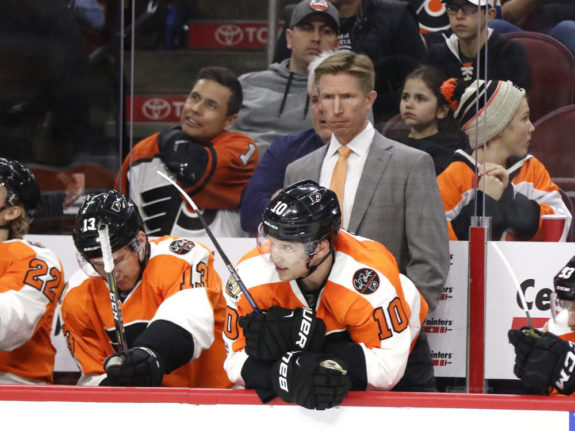
I mentioned Mason’s stellar numbers from those games down the stretch. Compare them to Neuvirth’s over the same time period and you have to wonder what the coach was thinking. Over that time period, Neuvirth had an .897 save percentage and 2.46 goals-against average.
Down the stretch, you should be playing your hot hand every chance you get, not throwing in the goalie who has proved to be incapable all season. That easily cost the Flyers a hefty amount of points and possibly a playoff spot.
Lastly, when it comes to coaching, you have to wonder about what happened.
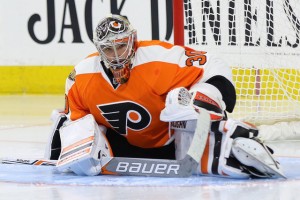
In all my years of covering this sport, I have never seen a season so split. In the first half of the season, the Flyers looked like a team that could have very well made a push in the playoffs, and then almost like the flip of a switch, come the second half they looked like a team that would be fighting for the number-one draft pick.
Once again, how does that happen?
It’s hard to blame coaching, but there isn’t really anywhere else to look.
The Flyers didn’t lose anyone overly important to injury, their goaltending and defense got better, but their offense just ceased to exist. That’s a systems problem that falls back on the coach and his staff.
The same rings true for the personnel decisions. Why wasn’t a guy like Jordan Weal brought in earlier? Why was MacDonald registering first-pair minutes? Why weren’t Bellemare and VandeVelde scratched as opposed to Konecny?
Those are decisions that seemed to have little merit behind them but ultimately affected the Flyers in big ways. Make no mistake about it, when a team suffers a downfall such as the one the Flyers went through, a large part of that blame falls on the coaching staff itself.
Coaching Grade: D+